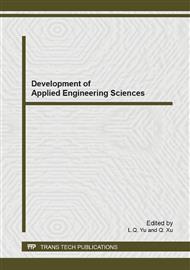[1]
Li Qunzu, Xia Qingguo, et al. Status and development of the urban traffic signal control system, J. Science Technology and Engineering, 2009, 9(24): 7436-7444.
Google Scholar
[2]
Dennis I. Robertson and R. David Bretherton. Optimizing networks of traffic signals in real time-The SCOOT method, J. IEEE Transactions on Vehicular Technology, 1991, 40(1): 11-15.
DOI: 10.1109/25.69966
Google Scholar
[3]
Pu Qi, Tan Yongzhao, et al. Signal- planning optimal model for intersection., J. Journal of Shanghai Tiedao University, 1997, 20(4): 31-34.
Google Scholar
[4]
Wang Weiping. Study of optimal method for the traffic control in urban plane intersection. Qingdao: Shangdong University of Science and Technology, (2004).
Google Scholar
[5]
Zhang Yuanyuan, Zhang Kaiwen, Mao Yuming. Research on vehicle detection method based on video image,C. 2012 International Conference on Industrial Control and Electronics Engineering, (2012).
DOI: 10.1109/icicee.2012.262
Google Scholar
[6]
Lu Bin, Niu Huimin. Signal timing optimization at isolated intersections under random condition, J. Journal of Traffic and Transportation Engineering, 2010, 10(6): 116-120.
Google Scholar
[7]
Xiao Yewei, Huang Huixian, Wang Chenhao. Multiphase traffic signal timing optimization of ant colony algorithm, J. Computer Engineer and Applications, 2008, 44(19): 221-224.
Google Scholar
[8]
Tian Feng, Bian Tingting. Traffic signal timing optimization based on adoptive genetic algorithm, J. Computer Simulation, 2010, 27(6): 305-308.
Google Scholar
[9]
Yi Jiang, Shuo Li, Daniel E. Shamo, A platoon-based traffic signal timing algorithm for major-minor intersection types, J. Transportation Research Part B, 2006, 40(7): 543-562.
DOI: 10.1016/j.trb.2005.07.003
Google Scholar
[10]
Francois Dion, Hesham Rakha, Youn-soo Kang. Comparison of delay estimates at under-saturated and over-saturated pre-timed signalized intersections, J. Transportation Research Part B, 2004, 38(2): 99-122.
DOI: 10.1016/s0191-2615(03)00003-1
Google Scholar
[11]
Akcelik R, Rouphail N M. Estimation of delays at traffic signals for variable demand conditions, J. Transportation Research Part B: Methodological, 1993, 27(2): 109-131.
DOI: 10.1016/0191-2615(93)90003-s
Google Scholar


